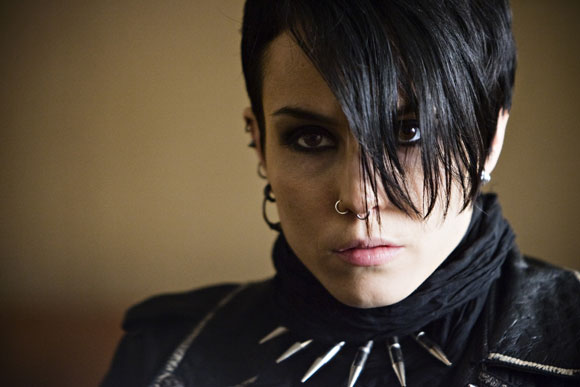Män Som Hatar Kvinnor (The Girl With the Dragon Tattoo)

Adapted from the first of Stieg Larsson’s Millennium Trilogy novels, The Girl With the Dragon Tattoo is a conventional thriller. It involves the disappearance of Harriet Vanger as investigated by a journalist, Mikael Blomkvist, recently convicted of libel against industrial titan Hans-Erik Wennerström (Stefan Sauk). Blomkvist accepts the sentence, advising his colleagues that it’ll be over soon enough and that it’s better for their publication, Millennium, to stay distanced from the controversy.
The film begins with parallel stories, Blomkvist’s and that of a young hacker, Lisbeth Salander (Noomi Rapace), contracted by Dirch Frode (Ingvar Hirdwell) to investigate Blomkvist after he’s already been convicted. We initially know nothing about Frode, except that he appears to be tasked with discrediting Millennium by way of the Blomkvist case. He isn’t. Instead, he works for Henrik Vanger, whose aforementioned niece disappeared from their estate in Hedestad in 1966.
Enter Lisbeth, who has been monitoring Blomkvist’s activity. A checkered past, Lisbeth is a powderkeg fueled by contempt for men. It takes her perspective to point out the relevance of Biblical passages encoded in messages Blomkvist finds. Whoever is responsible for Harriet’s disappearance has a special hatred toward women. This draws Lisbeth to the case, and to Blomkvist. She denies personal interest, but he observes, “You work as a professional hacker, yet you send me an e-mail I can easily trace.”
Through her, the film addresses two primary themes. The original Swedish title, Män Som Hatar Kvinnor, translates to Men Who Hate Women. It’s difficult to discuss without exposing key plot details. However, it becomes evident that Lisbeth’s probate guardian, Nils Bjurman (Peter Andersson), along with several members of the Vanger dynasty, are beyond mere misogyny. Noomi Rapace, irreplaceable as Lisbeth, carries the film well beyond the appeal of its otherwise routine plot with her deviant antihero—calculated and cunning yet childishly headstrong. Lisbeth is an enigmatic figure, suffering emotional scars kept from view until after we’ve had an opportunity to judge her character’s actions without the knowledge of the abuses she endured. This leads into the second theme, accountability.
Unlike many American films, which pander to the audience with easily digestible absolutes, The Girl With the Dragon Tattoo treats criminality as a grey area—at what point is an individual responsible for who family or society has made them? This question is asked of several characters, and poses an interesting conflict when one damaged person is presented the choice to repeat their past or rise above it, to the benefit or detriment of another.
The acting, cinematography and production design work well without being overstated. We aren’t treated to Dutch Angle abuse to falsely inflate tension. Instead, the story and the characterizations drive the suspense. Additionally, Blomkvist’s colleague is a woman who looks appropriately her age. In Hollywood, there are no old actors. There are young actors and then there are actors with enough surgery to try to conceal their actual age. As Pauline Kael noted once, Hollywood starlets do not seem to know how to age gracefully, and prefer to attempt playing shadows of their former selves for the rest of their careers once they’ve made it—the family matriarch being the sole exception, when all other attempts to conceal age have finally failed. However, here, Blomkvist’s colleage Erika Berger, played by Swedish film and television star Lena Endre (whom director Ingmar Bergman compared to a Stradivarius), hasn’t concealed wrinkles or crows feet. She looks like a journalist, not a motion picture star.
The story, however, is a mixed bag. Mostly it succeeds in creating and maintaining tension with its machinations—undercurrents of two larger conspiracies each involving separate business dynasties, with no apparent connection evident in this first episode. in the third act, however, several holes in the investigation are resolved from entirely out of nowhere. The few times when a plot twist is truly warranted in a movie, and not merely to turn the story on its head for sake of oohs and aahs, it’s more fascinating if you could go over the picture a second time and see the connections you missed. This adds a second dimension, whereby the meanings of key scenes and dialogues are suddenly shifted. But if the leads point nowhere, then suddenly you’re given information that neither you knew nor was revealed up until the very moment it is necessary to move the plot forward, there’s no opportunity for intellectual deconstruction or discourse.
That said, the film doesn’t reach for completely implausible cause-effect relationships. It’s possible to suspect what was going on, and it’s still interesting to see—once privy to these revelations—how the mystery continues to unfold around the Vanger clan and, lest we forget, Wennerström. We get some, but perhaps not enough, of a sense of the way in which the scandal destroys the Vangers, both internally as well as publicly. I’m hoping for this angle to be examined further in the second and third installments of the trilogy.
Footnote: I am loathe to inform you that David Fincher (a director I otherwise admire) and Scott Rudin are re-making the film for American audiences. This isn’t a film that needs to be re-made, and I can’t see any American actress as Lisbeth—save perhaps Maggie Gyllenhaal. Already having pulled in $100 million overseas, with high production value and excellent performances, I can’t see a reason not to simply get a wide release for the original. Are we Americans really incapable of reading subtitles?
 The Girl With the Dragon Tattoo • Dolby® Digital surround sound in select theatres • Aspect Ratio: 2.35:1 • Running Time: 152 minutes • Distributed by Music Box Films
The Girl With the Dragon Tattoo • Dolby® Digital surround sound in select theatres • Aspect Ratio: 2.35:1 • Running Time: 152 minutes • Distributed by Music Box Films